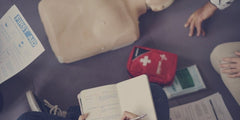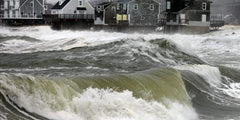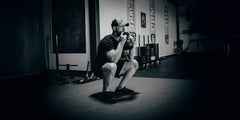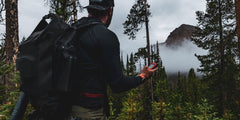
Injuries are practically inevitable in emergency situations. There’s a chance you get hurt by whatever’s causing the emergency; for instance, you could get burned in a fire, or you could get struck by toppling debris during an earthquake. But injuries are also sustained during the panic that ensues in an emergency. In the rush to get away from danger, you could sprain your ankle or suffer an open wound.
Here are 10 first aid “must-knows” that you can use to treat a broad array of injuries:
- Remember the “Three P’s.”
- Check the scene for danger before you provide help.
- To treat cuts and scrapes, apply gentle pressure, disinfectant, and bandages.
- To treat sprains, apply ice and compression at intervals and keep the limb elevated.
- To treat heat exhaustion, use cool fluids, cool cloths, and shade.
- To treat hypothermia; use warm fluids and warm covering.
- To treat burns, determine the burn type and severity. Cover the wound with loose cloth to prevent infection.
- Use an EpiPen to treat allergic reactions.
- To treat fractures, keep the fractured area stable and immobilized, and apply a cold pack.
- Perform CPR if an injured person stops breathing.
It’s important that you commit these 10 golden rules to memory. Even if you’re not injured, you might encounter someone who is, and who needs treatment.
Always attempt to seek professional medical help for injured persons. First responders are not always readily available during emergency situations, and if that’s the case, do your best to provide what treatment you can until help arrives. But never forget that serious injuries always require more advanced treatment, and you should do your best to get the injured person to professional caregivers.
Nonetheless, these simple first aid procedures can go a long way in helping someone who’s injured, and all you need to do is use a few materials in your survival kit and apply them in right manner. Read through these detailed guides on all 10 items.
1. The “Three P’s”
The “Three P’s” are the primary goals of first aid. They are:
- Preserve life
- Prevent further injury
- Promote recovery

These goals might seem overly simple, but they’re simple on purpose. When someone is injured, it’s all-too-easy to panic and forget what you need to do to provide assistance. The Three P’s remind you of the very basics: do what you can to save the person’s life; do what you can to keep them from sustaining further injuries; do what you can to help them heal.
2. Check the Scene for Danger
Before you provide help to an injured person, it’s important that you check the scene for danger. You don’t want to get yourself injured, too. This isn’t a cowardly precaution. The fact of the matter is this: if you get injured, you won’t be able to help someone else who’s injured. So before you rush to help someone, take a moment to analyze the area and spot anything that could injure you.
For example, there might be a terrible storm outdoors, and you spot someone outside who’s injured and who can’t make it to shelter. Before you go running outside to help them, look for hazards. Are strong winds hurling debris? Are there any trees or structures that look as if they’re about to fall? Are there downed power lines? Is there floodwater?
Once you’ve assessed these dangers, you can better strategize how to reach and rescue the injured person.
3. Treating Cuts and Scrapes
Blood is a vital component of our bodies. When someone is bleeding, you want to prevent as much blood from leaving their body as possible. Try and find a clean cloth or bandage. Then:
- Apply gentle pressure for 20 to 30 minutes.
- Clean the wound by gently running clean water over it. Avoid using soap on an open wound.
- Apply antibiotic to the wound, like Neosporin.
- Cover the wound with a bandage.
If someone has a nosebleed, have the person lean forward. Press a cloth against the nostrils until the blood flow stops.
The body is usually very quick at patching up small cuts and scrapes. But deeper wounds may require medical attention. With deep wounds:
- Apply pressure.
- Don’t apply ointments. Cover the area with loose cloth to prevent contaminants from infecting the wound.
- Seek medical attention as soon as possible.
4. Treating Sprains
Sprains are usually an unalarming injury, and most of the time they’ll heal on their own. But there are steps you can take to ease the swelling. Swelling is caused by blood flow to an injured area. You can reduce swelling by applying ice. Ice restricts the blood vessels, which reduces blood flow.
- Keep the injured limb elevated.
- Apply ice to the injured area. Don’t apply ice directly to the skin. Wrap it in a cloth or put ice in a plastic bag.
- Keep the injured area compressed. Put it in a brace or tightly wrap it. Don’t wrap it so tight that it’ll cut off circulation.
- Ice for a while. Then compress. Repeat at intervals.
Make sure the injured person avoids putting weight on the injured limb.

5. Treating Heat Exhaustion
Heat exhaustion occurs due to prolonged exposure to high temperatures, especially when the person is doing strenuous activities or hasn’t had enough water. Symptoms of heat exhaustion include:
- Cool, moist skin
- Heavy sweating
- Dizziness
- Weak pulse
- Muscle cramps
- Nausea
- Headaches
To treat someone with heat exhaustion:
- Get the person to a shaded area that’s out of the sun.
- If there are no shaded areas available, keep the person covered by any available materials that can block sunlight.
- Give the person water and keep them hydrated.
- Place a cool cloth on their forehead to lower their body temperature.
6. Treating Hypothermia
Hypothermia is caused by prolonged exposure to cold temperatures. It begins to occurs when your body temperature drops below 95 degrees Fahrenheit.
Symptoms of hypothermia include:
- Shivering
- Slurred speech or mumbling
- Week pulse
- Weak coordination
- Confusion
- Red, cold skin
- Loss of consciousness
To treat hypothermia:
- Be gentle with the afflicted person. Don’t rub their body and don’t move their body in too jarring of a way; this could trigger cardiac arrest.
- Move the person out of the cold, and remove any wet clothing.
- Cover the person with blankets and use heat packs. Don’t apply heat directly to the skin because this could cause major skin damage.
- Give the person warm fluids.
If you set the person on the ground, be aware that the ground may also be a cold source. Place warm materials on the ground that the person is going to lay on.
7. Treating Burns
Before you apply treatment to burns, you need to identify the burn type and the severity of the burn. There are four kinds of burns:

- First-degree burn: Only the outer layers of skin are burnt. The skin is red and swollen, and looks similar to a sunburn.
- Second-degree burn: Some of the inner layer of skin is burnt. Look for blistering skin and swelling. This is usually a very painful type of burn.
- Third-degree burn: All of the inner layer of skin is burnt. The wound has a whitish or blackened color. Some third-degree burns are so deep, there might not be any pain because the nerve endings are destroyed.
- Fourth-degree burn: A burn that has penetrated all tissues up to the tendons and bones.
Additionally, there are two kinds of burn severities: a minor burn and a major burn.
- Minor burn: First-degree burns and mild second-degree burns.
- Major burn: Moderate second-degree burns to fourth-degree burns.
Minor burns don’t usually need extensive treatment, but you could:
- Run cool water over the afflicted area (avoid icy or very cold water).
- Don’t break any blisters.
- Apply moisturizer over the area, like aloe vera.
- Keep the burned person out of sunlight.
- Have the burned person take ibuprofen or acetaminophen for pain relief.
Major burns are very serious injuries that require medical assistance. To help someone who has suffered from a major burn:
- Do not apply ointments.
- Cover wound with loose materials to prevent contaminants from infecting it.
8. Allergic Reactions
Allergic reactions occur when your body is hypersensitive to a foreign substance. Bee stings, certain foods, or drug ingredients can cause allergic reactions. Anaphylaxis is a life-threatening allergic reaction that can be caused by all of those mention allergens.
The best way to treat an allergic reaction is to use an EpiPen. EpiPen, or “epinephrine autoinjector,” is a small and ergonomic needle that’s used to inject epinephrine (adrenaline) into someone suffering greatly from an allergic reaction. The epinephrine usually subdues the effects of the allergic reaction.
If someone is suffering from an allergic reaction:
- Keep the person calm. Ask if they use an EpiPen and have one with them.
- Have the person lie on their back. Keep their feet elevated 12 inches.
- Make sure the person’s clothing is loose so they’re able to breathe.
- Avoid giving them food, drink, or medicine.
- If appropriate, use an EpiPen. Learn how to inject an EpiPen in someone having a reaction.
- Wait 5-15 minutes after using an EpiPen. If the allergic reaction isn’t subdued, a second dose may be required.

9. Treating Fractures
Sometimes it’s very easy to tell if someone has suffered a fractured bone. But sometimes it’s not. If you suspect someone of having a fracture:
- Don’t try to straighten a fractured limb.
- Use a splint or padding to stabilize the area and keep it from moving.
- Apply a cold pack to the area. Don’t apply it directly to the skin. Wrap it in a cloth or put it in a plastic bag.
- Keep the area elevated, if possible.
- Give the person an anti-inflammatory drug, like ibuprofen.
10. Performing CPR
CPR stands for cardiopulmonary resuscitation. CPR is used to restore breathing and blood circulation to an unresponsive person. CPR is an incredibly important procedure that can save lives. But learning CPR is an intensive procedure that requires some training, which is usually in the form of a day-long class. The American Red Cross offers CPR certification classes across the nation. Go to Redcross.org for more information.

Prepare Yourself with the Right Gear
The methods listed above are not very difficult to do and they don’t require medical training—but they can save someone’s life or prevent an injured person from sustaining serious injuries or infections. Make sure that your stash of survival gear includes a first aid kit, and be sure to refill your first aid kit every year as its supplies dwindle or expire.
The essential first aid kit should include:
- Anti-bacterial wipes
- Painkillers
- Gauze pads
- Sunscreen
- Medical gloves
- Medical instrument kit
- Sling
- Burn gel
- Antibiotic ointment
- Antiseptic wipes
- First aid instructions
- Tourniquet
Download our first aid checklist and make sure you’re ready for anything you may encounter.
So long as you have a functioning survival kit, you’ll be prepared to give treatment to yourself or others when an emergency situation causes injury.




